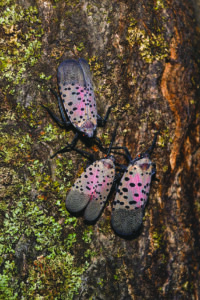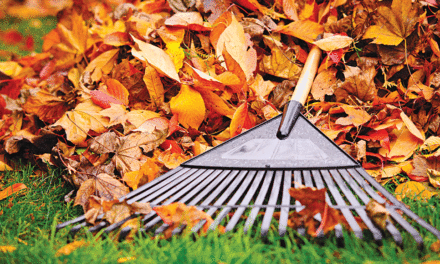
A group of three Spotted Lanternflies feeds on a Tree of Heaven, killing it in the process.
This month we’re focusing on how to perfectly plant bulbs and helping you understand more about the invasive Spotted Lanternfly.
It’s also the season of giving thanks, so we’d like to take a moment to thank all customers of Robin’s Nest Floral & Garden Center.
Whether you’ve only ordered flowers, you’ve stopped in one time, or you shop with us frequently, we appreciate you no matter what!
Although it’s getting colder, there’s still some time to plant this season.
Nursery stock (container or balled and burlapped) deciduous trees and shrubs can be planted until the ground freezes.
Daffodils, tulips and other spring-flowering bulbs can be planted until the ground freezes, as well.
Planting in drifts of a dozen or more of one variety is sure to stun during the blooming season.
Drifts are defined as a ribbon of the same plant that meanders across the landscape.
When planting, be sure to plant your bulbs with the pointed side up — this is where the stem will grow out of.
Adding fertilizer before the bulbs go in is going to give them larger blooms and a much stronger root system.
Espoma Bulb Tone has a great mix of bone meal, bio-tone, and other organic ingredients to help make the magic happen.
Important note: According to the Maryland Lawn Fertilizer Law, fertilizer cannot be applied to Maryland lawns by homeowners between Nov. 15 and March 1.
Before the first anticipated hard freeze, be sure to water all your trees and shrubs, including bulbs and perennial beds.
You’ll need to provide at least an inch of rain per week. Remember, if the sky doesn’t provide rain, you need to.
Allowing the soil to completely dry out will provide no moisture protection for the roots of your trees and shrubs when the ground freezes.
Remember, just because the air temperatures are cooler, the ground temperatures will sometimes remain warmer longer.
Every weed you pull now will be less to remove in spring.
Let your lawnmower work for you by shredding the weeds in your yard as you mow.
Weeds in garden beds should be removed by hand — grab by the base and pull slowly and steadily to ease the roots out of the soil.
If the weeds in your yard are stubborn and snapping, Robin’s Nest has the tools you need for getting those roots out.
After Nov. 15 you can begin pruning deciduous trees and shrubs.
Begin by first removing all dead branches, stumps on scaffold limbs and rubbing or wounded branches. After this step you can prune for plant form.
The direction of new growth can be influenced by pruning off undesirable growth just above a bud that is placed on the stem in a direction you want the new growth to go.
Have you ever heard the term “frost heave?”
Frost heave refers to the volume increase in soil and accompanying surface displacement that results from the accumulation of ice in the soil profile — in other words, the freezing and thawing soil displaces plants by pushing them upward.
You can begin mulching your perennials after the first hard frost. Be sure to have it done before the first significant snowfall.
Mulch helps moderate temperature changes, helping to protect your plants roots and preserving soil moisture.
Spotted Lanternflies have unfortunately made their way to the Eastern Shore.
If you’re unfamiliar with the Spotted Lanternfly, it’s an invasive pest that if allowed to spread in the United States could immensely impact the country’s grape, orchard, and logging industries.
They cause stunted growth, localized damage and reduced yields.
If you spot them or any of their egg masses, please report your findings to the Maryland Department of Agriculture by e-mailing DontBug.MD@maryland.gov.
A photograph is required. Residents are no longer required to report sightings in Cecil or Harford counties.
Signs include plants that are oozing or weeping and have a fermented odor, buildup of sticky fluid on plants or on the ground beneath the infested plant, and/or sooty mold on infested plants.
Egg masses look similar to cracked mud, and can be laid on any surface such as outdoor light bulbs, outdoor furniture, fence posts, vehicles, children’s yard toys, etc.
Adults are light brown with black spots, however when their wings are spread, their back wings are visible with a prominent red covered in black spots and black-and-white bands.
Their favorite host is Tree of Heaven (Ailanthus altissima). Some plants that are at risk include: grape, black walnut, red maple, silver maple, eastern white pine, weeping willow, black willow, black cherry, sycamore.
Keep in mind that this is not a complete list because they feed on over 70 plant species.
If you need help understanding what to look for, the USDA has some excellent printable resources available on their website.
Happy gardening, and have a blessed Thanksgiving!
(Editor’s Note: Ken Morgan is the owner of Robin’s Nest Floral and Garden Center in Easton, Md.)




